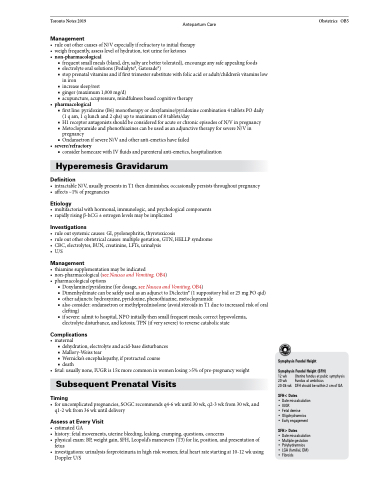Page 845 - TNFlipTest
P. 845
Toronto Notes 2019 Antepartum Care
Management
• ruleoutothercausesofN/Vespeciallyifrefractorytoinitialtherapy • weighfrequently,assesslevelofhydration,testurineforketones
• non-pharmacological
■ frequent small meals (bland, dry, salty are better tolerated), encourage any safe appealing foods
■ electrolyte oral solutions (Pedialyte®, Gatorade®)
■ stop prenatal vitamins and if first trimester substitute with folic acid or adult/children’s vitamins low
in iron
■ increase sleep/rest
■ ginger(maximum1,000mg/d)
■ acupuncture, acupressure, mindfulness based cognitive therapy
• pharmacological
■ first line: pyridoxine (B6) monotherapy or doxylamine/pyridoxine combination 4 tablets PO daily (1 q am, 1 q lunch and 2 qhs) up to maximum of 8 tablets/day
■ H1 receptor antagonists should be considered for acute or chronic episodes of N/V in pregnancy
■ Metoclopramide and phenothiazines can be used as an adjunctive therapy for severe N/V in
pregnancy
■ Ondansetron if severe N/V and other anti-emetics have failed
• severe/refractory
■ consider homecare with IV fluids and parenteral anti-emetics, hospitalization
Hyperemesis Gravidarum
Definition
• intractableN/V,usuallypresentsinT1thendiminishes;occasionallypersiststhroughoutpregnancy • affects~1%ofpregnancies
Etiology
• multifactorialwithhormonal,immunologic,andpsychologicalcomponents • rapidlyrisingβ-hCG±estrogenlevelsmaybeimplicated
Investigations
• ruleoutsystemiccauses:GI,pyelonephritis,thyrotoxicosis
• ruleoutotherobstetricalcauses:multiplegestation,GTN,HELLPsyndrome • CBC, electrolytes, BUN, creatinine, LFTs, urinalysis
• U/S
Management
• thiaminesupplementationmaybeindicated
• non-pharmacological(seeNauseaandVomiting,OB4) • pharmacologicaloptions
■ Doxylamine/pyridoxine (for dosage, see Nausea and Vomiting, OB4)
■ Dimenhydrinate can be safely used as an adjunct to Diclectin® (1 suppository bid or 25 mg PO qid) ■ other adjuncts: hydroxyzine, pyridoxine, phenothiazine, metoclopramide
■ also consider: ondansetron or methylprednisolone (avoid steroids in T1 due to increased risk of oral
clefting)
■ if severe: admit to hospital, NPO initially then small frequent meals; correct hypovolemia,
electrolyte disturbance, and ketosis; TPN (if very severe) to reverse catabolic state
Complications
• maternal
■ dehydration, electrolyte and acid-base disturbances ■ Mallory-Weiss tear
■ Wernicke’s encephalopathy, if protracted course
■ death
• fetal:usuallynone,IUGRis15xmorecommoninwomenlosing>5%ofpre-pregnancyweight
Subsequent Prenatal Visits
Timing
• foruncomplicatedpregnancies,SOGCrecommendsq4-6wkuntil30wk,q2-3wkfrom30wk,and q1-2 wk from 36 wk until delivery
Assess at Every Visit
• estimatedGA
• history:fetalmovements,uterinebleeding,leaking,cramping,questions,concerns
• physical exam: BP, weight gain, SFH, Leopold’s maneuvers (T3) for lie, position, and presentation of
fetus
• investigations:urinalysisforproteinuriainhighriskwomen;fetalheartratestartingat10-12wkusing
Doppler U/S
Obstetrics OB5
Symphysis Fundal Height Symphysis Fundal Height (SFH)
12 wk 20 wk 20-36 wk
Uterine fundus at pubic symphysis Fundus at umbilicus
SFH should be within 2 cm of GA
SFH< Dates
• Date miscalculation • IUGR
• Fetal demise
• Oligohydramnios
• Early engagement
SFH> Dates
• Date miscalculation • Multiple gestation • Polyhydramnios
• LGA (familial, DM) • Fibroids


